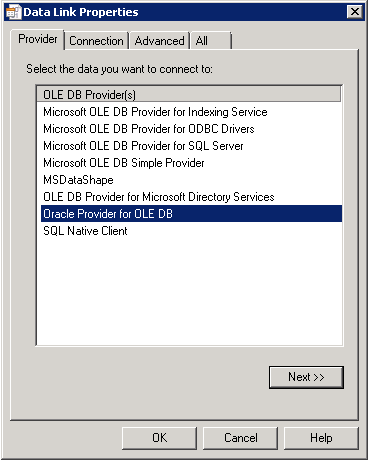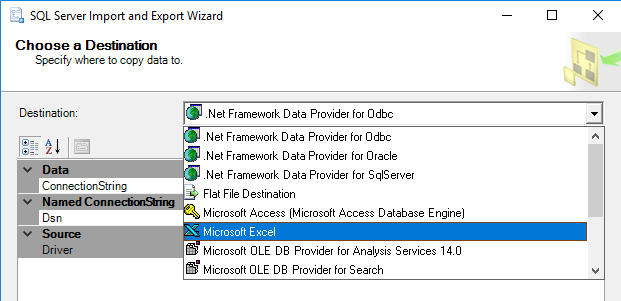- I am using Micorsoft OLE DB provider for oracle for creating a connection manager to connect to ORACLE 10 g. The package runs great in my local PC. When I move the package to the Server ( Microsoft windows server 2003 R2, Enterprise x64 edition) which also has SQL server 2005.
- OLE DB Driver for SQL Server was designed to provide a simplified method of gaining native data access to SQL Server using OLE DB. It provides a way to innovate and evolve new data access features without changing the current Windows DAC components, which are now part of the Microsoft Windows platform.
- Aug 07, 2006 Oracle 64 bit OLEDB Driver? 513005 May 15, 2006 2:10 PM Hello, we have just completed a proof of concept project where we were successfully able to setup / configure and execute SQL Server 2005 Transactional replication to our Oracle 9i database (32 bit environment). For our production deployment, we would like to configure a 64 bit hardware.
- Using with Microsofts OLE DB.NET Data Provider The Microsoft OLE DB.NET Data Provider can utilize OraOLEDB as the OLE DB Provider for accessing Oracle. However this must be enabled in the connection string.
- Oracle Oledb Driver For Ssis
- Oracle Oledb Driver 64 Bit
- Microsoft Oledb For Oracle
- Oracle Ole Db Driver 11g
This post is a walkthrough of creating a Linked Server to Oracle from 64bit SQL Server. There's lots of information on doing this on the web, but much of it is out-of-date.
Oracle Provider for OLE DB 12.1.0.2 now supports the IRowsetFastLoad interface, which enables fast memory-based bulk-copy operations in the Oracle database. This interface also works with the SQL Server Integration Services fast-load functionality to permit rapid ingestion of large amounts of data to the Oracle database. May 14, 2019 Microsoft OLE DB Driver 18 for SQL Server is a single dynamic-link library (DLL) containing run-time support for applications using native-code APIs to connect to Microsoft SQL Server 2012, SQL Server 2014, SQL Server 2016, SQL Server 2017, Analytics Platform System, Azure SQL Database and Azure SQL Data Warehouse. The Microsoft OLE DB Provider for ODBC (MSDASQL) is a technology that allows applications that are built on OLEDB and ADO (which uses OLEDB internally) to access data sources through an ODBC driver. MSDASQL is an OLEDB provider that connects to ODBC, instead of a database.
First, install the correct Oracle drivers. You want the latest version of the Oracle Data Access Components (ODAC), and you want the XCopy deployment. They are available here:
One you download and unzip this into a folder run the following command from that folder:
C:UsersdbrowneDownloadsODAC121010Xcopy_x64>.install.bat oledb c:oracleodac64 odac64 true
Then you need to add two folders to your system path: c:oracleodac64 and c:oracleodac64bin
Then you must reboot for the system path change to be visible by services like SQL Server.
After reboot you're ready to create and test the linked server.
First configure the Oracle OleDB provider to run inside the SQL Server process, and configure it to accept parameters.
Then create the linked server definition. Instead of a TNSNames alias, use an EZConnect identifier. Here I'm specifying an IP address and a SID to connecto to an Oracle Express instance running on a VM:
Now you're ready to test. We configured the linked server for 'rpc out' so we can send a simple passthrough query to test connectivity:
That's it.
This chapter introduces Oracle Provider for OLE DB (OraOLEDB).
This chapter contains these topics:
1.1 Overview of OLE DB
OLE DB is an open standard data access methodology which utilizes a set of Component Object Model (COM) interfaces for accessing and manipulating different types of data. These interfaces are available from various database providers.
1.1.1 OLE DB Design
The design of OLE DB centers around the concept of a consumer and a provider. Figure 1-1 is an illustration of the OLE DB system. The consumer represents the traditional client. The provider places data into a tabular format and returns it to the consumer.
Figure 1-1 OLE DB Flow
 Description of 'Figure 1-1 OLE DB Flow'
Description of 'Figure 1-1 OLE DB Flow'OLE DB Data Providers
OLE DB data providers are a set of COM components that transfer data from a data source to a consumer. An OLE DB Provider places that data in a tabular format in response to calls from a consumer. Providers can be simple or complex. A provider may return a table, it may allow the consumer to determine the format of that table, and it may perform operations on the data.
Each provider implements a standard set of COM interfaces to handle requests from the consumer. A provider may implement optional COM interfaces to provide additional functionality.
With the standard interfaces, any OLE DB consumer can access data from any provider. Because of COM components, consumers can access them in any programming language that supports COM, such as C++, Visual Basic, and Java.
OLE DB Data Consumers
The OLE DB data consumer is any application or tool that utilizes OLE DB interfaces of a provider to access a broad range of data.
1.2 Overview of OraOLEDB
Oracle Provider for OLE DB (OraOLEDB) is an OLE DB data provider that offers high performance and efficient access to Oracle data by OLE DB consumers.

In general, this developer's guide assumes that you are using OraOLEDB through OLE DB or ADO.
For sample code, the latest patches, and other technical information on the Oracle Provider for OLE DB, go to
With the advent of the .NET framework, support has been provided for using the OLEDB.NET Data Provider with OraOLEDB. With the proper connection attribute setting, an OLEDB.NET Data Provider can utilize OraOLEDB to access Oracle Database.
See Also:
'OLEDB.NET Data Provider Compatibility' for further information on support for OLEDB.NET Data Provider1.3 System Requirements
The following items are required on a system to use Oracle Provider for OLE DB:
Windows Operating System:
32-bit: Windows Vista (Business, Enterprise, and Ultimate Editions), Windows Server 2003, Windows Server 2003 R2, Windows 2000 or Windows XP Professional Edition.
64 bit: Windows Vista x64 (Business, Enterprise, and Ultimate Editions), Windows Server 2003 x64, Windows Server 2003 R2 x64, or Windows XP x64.
64-bit: Windows Server 2003 for Itanium-based systems.
Access to an Oracle Database (Oracle 9.2 or later)
Oracle Client release 11.1 or later and Oracle Net Services (included with Oracle Provider for OLE DB installation).
Redistributable files provided with Microsoft Data Access Components (MDAC) 2.1 or higher are required by the provider. These files are available at the Microsoft Web site:
Oracle Services for Microsoft Transaction Server release 11.1 or higher. This is required for consumers using Microsoft Transaction Server (MTS) or COM+.
1.4 OraOLEDB Installation
Oracle Provider for OLE DB is included as part of your Oracle installation. It contains the features and demos that illustrate how to use this product to solve real-world problems.
See Also:
The Oracle Database Installation Guide for Windows for installation instructionsDuring the installation process, the files listed in Table 1-1 are installed on the system. Some files have ver in their name to indicate the release version.
Table 1-1 Oracle Provider for OLE DB Files
| File | Description | Location |
|---|---|---|
| Oracle Provider for OLE DB |
|
| Oracle rowset file cache manager |
|
| Oracle rowset memory cache manager |
|
| Oracle rowset |
|
| Oracle ODBC SQL parser |
|
where | Language-specific resource DLL |
|
| Property descriptions |
|
| OraOLEDB utility DLL |
|
| OraOLEDB type library |
|
| OraOLEDB header file |
|
| OraOLEDB library file |
|
where | Language-specific message file |
|
readme and documentation files | Release notes and online documentation |
|
sample files | Sample code |
|
Oracle Oledb Driver For Ssis
1.5 Component Certifications
Oracle Oledb Driver 64 Bit
Oracle provides support information for components on various platforms, lists compatible client and database versions, and identifies patches and workaround information.
Microsoft Oledb For Oracle
Find the latest certification information at:
Oracle Ole Db Driver 11g

You must register online before using OracleMetaLink. After logging into OracleMetaLink, select Product Lifecycle from the left column. From the Products Lifecycle page, click Certifications. Other Product Lifecycle options include Product Availability, Desupport Notices, and Alerts.